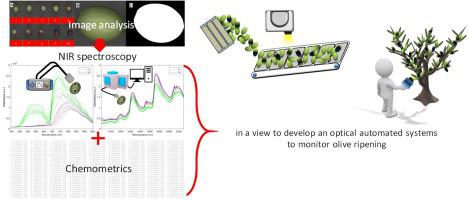当前位置:
X-MOL 学术
›
Comput. Electron. Agric.
›
论文详情
Our official English website, www.x-mol.net, welcomes your feedback! (Note: you will need to create a separate account there.)
A diagnostic visible/near infrared tool for a fully automated olive ripeness evaluation in a view of a simplified optical system
Computers and Electronics in Agriculture ( IF 8.3 ) Pub Date : 2021-01-01 , DOI: 10.1016/j.compag.2020.105887 A. Tugnolo , V. Giovenzana , R. Beghi , S. Grassi , C. Alamprese , A. Casson , E. Casiraghi , R. Guidetti
Computers and Electronics in Agriculture ( IF 8.3 ) Pub Date : 2021-01-01 , DOI: 10.1016/j.compag.2020.105887 A. Tugnolo , V. Giovenzana , R. Beghi , S. Grassi , C. Alamprese , A. Casson , E. Casiraghi , R. Guidetti

|
Abstract A diagnostic visible/near infrared tool calibrated by means of image analysis,was proposed to evaluate the maturation degree of oil olives in order to replace traditional subjective methods in a view of future fully automated applications. Thirteen varieties of Olea europaea deriving from four regions of the south of Italy were analyzed. In order to objectify the ripening stage assessment, the RGB image was acquired. Spectroscopic analyses were performed using a benchtop FT-NIR and a portable vis/NIR instrument. The benchtop device was equipped with an optical fiber probe and the spectra were collected over the 800–2500 nm range, nominal resolution of 1.6 nm; the portable spectrophotometer cover the range of 400–1000 nm, nominal resolution 0.3 nm. The olive spectral data were modelled using Partial Least Squares - Discriminant Analysis (PLS-DA). The prediction capability reached by the global model (13 varieties were used) obtained from data acquired with both the devices results promising. The PLS-DA models calculated on the olives from Calabria, Sardinia and Abruzzo revealed high prediction capabilities, i.e. sensitivity, specificity and accuracy higher than 83%. The prediction capability of Apulia samples could be improved increasing the variability of the samples since for this region only 3 sampling times were considered. To compare the modelling performance between the benchtop FT-NIR and the portable vis/NIR device, a McNemar’s test was performed resulting no significant difference between the PLS-DA global models. Finally, considering the good performance of the vis/NIR model, a variable selection using the interval PLS (iPLS) algorithm was applied. To reduce the complexity keeping the performance of the model built using the whole vis/NIR spectra (1647 variables), 12 bands (1.5 nm wide) were selected. The new model showed an improvement in terms of model stability and complexity (Sensitivity 86%; Specificity 87%; Accuracy 87%) than the two global models built with the whole vis/NIR and NIR range. The classification performance provided the groundwork for the development of (i) simplified systems for a direct olives ripening determination on the olive tree, and (ii) automated systems to be applied both in field and at the mill for olives sorting according to the ripening degree.
中文翻译:

从简化的光学系统角度进行全自动橄榄成熟度评估的诊断可见/近红外工具
摘要 针对未来全自动应用,提出了一种通过图像分析校准的可见/近红外诊断工具来评估油橄榄的成熟度,以取代传统的主观方法。分析了来自意大利南部四个地区的 13 种油橄榄品种。为了使成熟阶段评估客观化,获取了 RGB 图像。使用台式 FT-NIR 和便携式 vis/NIR 仪器进行光谱分析。台式设备配备了光纤探头,在 800-2500 nm 范围内收集光谱,标称分辨率为 1.6 nm;便携式分光光度计覆盖范围为 400-1000 nm,标称分辨率为 0.3 nm。橄榄光谱数据使用偏最小二乘法 - 判别分析 (PLS-DA) 建模。全局模型(使用了 13 个变体)从使用这两种设备获取的数据中获得的预测能力结果很有希望。对来自卡拉布里亚、撒丁岛和阿布鲁佐的橄榄计算的 PLS-DA 模型显示出很高的预测能力,即灵敏度、特异性和准确度高于 83%。普利亚样本的预测能力可以提高,增加样本的可变性,因为对于这个区域只考虑了 3 个采样时间。为了比较台式 FT-NIR 和便携式 vis/NIR 设备之间的建模性能,进行了 McNemar 测试,结果 PLS-DA 全局模型之间没有显着差异。最后,考虑到vis/NIR模型的良好性能,应用了使用间隔 PLS (iPLS) 算法的变量选择。为了降低使用整个可见光/近红外光谱(1647 个变量)构建的模型性能的复杂性,选择了 12 个波段(1.5 nm 宽)。与使用整个 vis/NIR 和 NIR 范围构建的两个全局模型相比,新模型在模型稳定性和复杂性(灵敏度 86%;特异性 87%;准确度 87%)方面均有改进。分类性能为以下开发奠定了基础:(i) 用于在橄榄树上直接确定橄榄成熟度的简化系统,以及 (ii) 用于根据成熟度进行橄榄分选的自动化系统,用于在田间和工厂中进行分类. 为了降低保持使用整个可见光/近红外光谱(1647 个变量)构建的模型性能的复杂性,选择了 12 个波段(1.5 nm 宽)。与使用整个 vis/NIR 和 NIR 范围构建的两个全局模型相比,新模型在模型稳定性和复杂性(灵敏度 86%;特异性 87%;准确度 87%)方面均有改进。分类性能为以下开发奠定了基础:(i) 用于在橄榄树上直接确定橄榄成熟度的简化系统,以及 (ii) 用于根据成熟度进行橄榄分选的自动化系统,用于在田间和工厂中进行分类. 为了降低使用整个可见光/近红外光谱(1647 个变量)构建的模型性能的复杂性,选择了 12 个波段(1.5 nm 宽)。与使用整个 vis/NIR 和 NIR 范围构建的两个全局模型相比,新模型在模型稳定性和复杂性(灵敏度 86%;特异性 87%;准确度 87%)方面均有改进。分类性能为以下开发奠定了基础:(i) 用于在橄榄树上直接确定橄榄成熟度的简化系统,以及 (ii) 用于根据成熟度进行橄榄分选的自动化系统,用于在田间和工厂中进行分类. 精度 87%) 比使用整个可见光/近红外和近红外范围构建的两个全球模型。分类性能为以下开发奠定了基础:(i) 用于在橄榄树上直接确定橄榄成熟度的简化系统,以及 (ii) 用于根据成熟度进行橄榄分选的自动化系统,用于在田间和工厂中进行分类. 精度 87%) 比使用整个可见光/近红外和近红外范围构建的两个全球模型。分类性能为以下开发奠定了基础:(i) 用于在橄榄树上直接确定橄榄成熟度的简化系统,以及 (ii) 用于根据成熟度进行橄榄分选的自动化系统,用于在田间和工厂中进行分类.
更新日期:2021-01-01
中文翻译:

从简化的光学系统角度进行全自动橄榄成熟度评估的诊断可见/近红外工具
摘要 针对未来全自动应用,提出了一种通过图像分析校准的可见/近红外诊断工具来评估油橄榄的成熟度,以取代传统的主观方法。分析了来自意大利南部四个地区的 13 种油橄榄品种。为了使成熟阶段评估客观化,获取了 RGB 图像。使用台式 FT-NIR 和便携式 vis/NIR 仪器进行光谱分析。台式设备配备了光纤探头,在 800-2500 nm 范围内收集光谱,标称分辨率为 1.6 nm;便携式分光光度计覆盖范围为 400-1000 nm,标称分辨率为 0.3 nm。橄榄光谱数据使用偏最小二乘法 - 判别分析 (PLS-DA) 建模。全局模型(使用了 13 个变体)从使用这两种设备获取的数据中获得的预测能力结果很有希望。对来自卡拉布里亚、撒丁岛和阿布鲁佐的橄榄计算的 PLS-DA 模型显示出很高的预测能力,即灵敏度、特异性和准确度高于 83%。普利亚样本的预测能力可以提高,增加样本的可变性,因为对于这个区域只考虑了 3 个采样时间。为了比较台式 FT-NIR 和便携式 vis/NIR 设备之间的建模性能,进行了 McNemar 测试,结果 PLS-DA 全局模型之间没有显着差异。最后,考虑到vis/NIR模型的良好性能,应用了使用间隔 PLS (iPLS) 算法的变量选择。为了降低使用整个可见光/近红外光谱(1647 个变量)构建的模型性能的复杂性,选择了 12 个波段(1.5 nm 宽)。与使用整个 vis/NIR 和 NIR 范围构建的两个全局模型相比,新模型在模型稳定性和复杂性(灵敏度 86%;特异性 87%;准确度 87%)方面均有改进。分类性能为以下开发奠定了基础:(i) 用于在橄榄树上直接确定橄榄成熟度的简化系统,以及 (ii) 用于根据成熟度进行橄榄分选的自动化系统,用于在田间和工厂中进行分类. 为了降低保持使用整个可见光/近红外光谱(1647 个变量)构建的模型性能的复杂性,选择了 12 个波段(1.5 nm 宽)。与使用整个 vis/NIR 和 NIR 范围构建的两个全局模型相比,新模型在模型稳定性和复杂性(灵敏度 86%;特异性 87%;准确度 87%)方面均有改进。分类性能为以下开发奠定了基础:(i) 用于在橄榄树上直接确定橄榄成熟度的简化系统,以及 (ii) 用于根据成熟度进行橄榄分选的自动化系统,用于在田间和工厂中进行分类. 为了降低使用整个可见光/近红外光谱(1647 个变量)构建的模型性能的复杂性,选择了 12 个波段(1.5 nm 宽)。与使用整个 vis/NIR 和 NIR 范围构建的两个全局模型相比,新模型在模型稳定性和复杂性(灵敏度 86%;特异性 87%;准确度 87%)方面均有改进。分类性能为以下开发奠定了基础:(i) 用于在橄榄树上直接确定橄榄成熟度的简化系统,以及 (ii) 用于根据成熟度进行橄榄分选的自动化系统,用于在田间和工厂中进行分类. 精度 87%) 比使用整个可见光/近红外和近红外范围构建的两个全球模型。分类性能为以下开发奠定了基础:(i) 用于在橄榄树上直接确定橄榄成熟度的简化系统,以及 (ii) 用于根据成熟度进行橄榄分选的自动化系统,用于在田间和工厂中进行分类. 精度 87%) 比使用整个可见光/近红外和近红外范围构建的两个全球模型。分类性能为以下开发奠定了基础:(i) 用于在橄榄树上直接确定橄榄成熟度的简化系统,以及 (ii) 用于根据成熟度进行橄榄分选的自动化系统,用于在田间和工厂中进行分类.


























 京公网安备 11010802027423号
京公网安备 11010802027423号